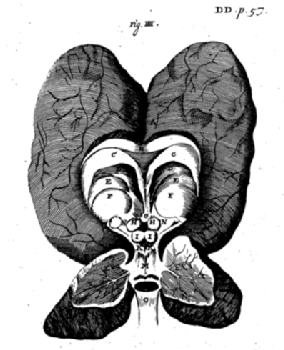A Day in History…The Day of the Fool Dissection (1660s?)
The ‘outward coverings’ were taken off first; we must assume that this means the hair and skin. By using a saw, scissors, and penknife, sections of the skull were then removed, one piece at a time. The specimen could then be examined and appraised in its full glory.(1)
Without being a pathologist or neurosurgeon it is hard to say whether or not such a thing as a ‘normal’ brain dissection really exists. What is certain is that on one day in the 1660s (the precise date cannot be known for sure(2)) Thomas Willis, the notable anatomist and physician, directed a brain dissection that was particularly unusual. Its findings were so striking that it became one of the very few brains which Willis asked his friend Christopher Wren to reproduce in the form of an anatomical diagram (Figure 1). What made this particular brain so unique was the nature of where it had come from. Willis describes the owner of the brain as ‘a certain youth that was foolish from his birth’(3); this was the first recorded examination of the brain of an idiot, and the significance of this event, it could be argued, can be felt to this day.
*
Before Willis published Cerebri Anatome in 1664 the traditional method of dissecting brains was to leave part of the skull intact and begin cutting into the organ in situ.(4) Willis’s deviation from this process is vital because it allowed him gradually to build an impression of the general size and appearance of a complete and normal brain. With this ‘ideal-type’ brain established in his mind, Willis approached the dissection of the idiot’s brain with the ability to spot any deviations.(5)

| Figure 1. Wren’s sketch of the Fool’s brain, from Willis’s The Anatomy of the Brain. The brain has been split open and pulled apart to reveal the inside for the benefit of the reader. |
Willis was not the first writer to suggest that there was a relationship between idiocy and the size of one’s brain. Galen of Pergamum established this relationship 1500 years earlier in chapter 11 of The Art of Physik, entitled ‘Of the Bigness and Smallness of the Head’. He wrote that:
A Very smal Head is a proper Indication of a vicious Brain[…]If there be not capacity enough in the Skull to hold the Brain, or a sufficient quantity of Brain, the Man must needs be a Fool.(7)
Clearly, therefore, the discourse existed prior to the Day of the Dissection of the Fool, however the Galenic system of medicine was being consistently questioned by observational medicine and science in the seventeenth century; it would have been quite possible for Willis to launch a damaging challenge to Galen’s hypothesis. But instead of Willis’s findings challenging Galen’s error, his conclusions sustained the power of that discourse and imbued it with even greater authority.Sure enough, Willis comments that ‘When of late we had dissected the Carcass of a man that was a Fool from his Birth, we could find no defect or fault in the Brain, unless that its substance or bulk was very small’.(6) This passing comment appears to be fairly insignificant; however, with hindsight, this event takes on considerable importance as the first authoritative account based upon observational medicine which associates brain size with intellect.
The findings on that day unquestionably contributed to Willis’s general theory of idiocy which he expressed in his Two Discourses Upon the Souls of Brutes (1672). Fleshing out his original observations, Willis suggested that
It is a vulgar observation, That the wit and ingenuity doth depend somewhat on the magnitude and figure of the Head, and consequently of its Brain; for as to its bulk, it is a Proverb, that it argues little of Brain or too much Foolishness. And although this does not always happen, yet it does for the most part. The reason of which is, because in a little Brain but a few Spirits are begotten and exercised.(8)
Assessing the significance of any single event or day necessarily relies on some counterfactual assumptions, but it would not be a stretch to suggest that if Willis had found something other than an unusually small brain in the head of the fool (a perfectly possible scenario, if Willis was presenting his findings accurately and without substantial bias), his theory of idiocy may well have developed quite differently and the discourse relating intellect to brain size may not have been enhanced in the same way.(9) The hypothetical possibility that Willis may have reached a different conclusion if he had dissected the brain of a different fool demonstrates the significance of the specific events as they took place on that day.

| Thomas Willis in 1667 |
The importance of that day is directly related to the influence of Willis’s findings; it is therefore worth taking a moment to consider how credible Willis’s hypotheses were within the scientific community. The extent of the impact of Willis’s writing on the brain is indicated by his mention in sources such as Ysbrand van Diemerbroeck’s The Anatomy of Human Bodies (1694) and Humphrey Ridley’s The anatomy of the brain (1695). Diemerbroeck suggests that ‘He that cannot acknowledge the Excellency of our Willis for his Anatomy of the Brain, must never pretend to the subject Discourse’(10) and while Ridley does not blindly accept all of Willis’s arguments he rarely makes a hypothesis without relating it to the writing of ‘the learned Dr. Willis’.(11)
Perhaps Willis’s most notable influence was upon John Locke, who would even occasionally help Willis in his anatomical explorations and experiments.(12) The record of the Day of the Dissection of the Fool appears to have had an impact on John Locke’s influential theory of idiocy in the Essay Concerning Human Understanding (1689). Willis gave weight to the idea that non-rational humans were inherently different in the head by saying the subject of his dissection was ‘of that sort which are commonly termed Changelings; the bulk of whose Brain […] was thinner and lesser than is usual’.(13) Sure enough, In the Essay, Locke presents a very similar idea in more general terms. He argues that:
Nobody will doubt that the wheels or springs (if I may so say) within, are different in a RATIONAL MAN and a CHANGELING; no more than that there is a difference in the frame between a DRILL [a primate] and a CHANGELING.(14)
These brief examples give a small but clear indication of the impact of Willis’s theory of brains and fools upon subsequent medical and scientific writings and even upon John Locke’s philosophy of mind.
*
In the introduction to this piece it was suggested that the impact of Willis’s findings in the fool’s head could be felt to this day. Of course any argument based upon the modern repercussions of a day in the seventeenth century will be based upon a string of assumptions, but there is undoubtedly a debate to be had about the long term impact of Willis’s findings on that day. As Stephen Jay Gould has persuasively argued in The Mismeasure of Man (1981), the relationship between brain size and intelligence was a defining feature of nineteenth and twentieth century psychology, yet very little work has been done tracing the historical roots of that discourse. It is this author’s belief that Thomas Willis’s dissection of the brain of an idiot and his subsequent findings played a vital role in embedding that view into the realm of observation-based science.
By Tom Colville an MA in History student who is currently researching the multifarious conceptions of idiocy in the seventeenth century, with a view eventually to exploring the nature of intelligence more generally in that period.
References
(1)Thomas Willis’s method of dissecting the brain is explicated in The Anatomy of the Brain. This can be viewed in Thomas Willis, ‘The Anatomy of the Brain’, in Dr. Willis’s Practice of Physik[…], (London, 1684), p. 46.
(2)That is, the date is not given in any of the printed records; it is possible that the date could be discovered through a thorough search of Willis’s case books.
(3)Willis, ‘The Anatomy of the Brain’, p. 57.
(4)For details see Ҫaǧatay Üstϋn, ‘Dr. Thomas Willis’s Famous Eponym: The Circle of Willis’, short report in Turk J Med Sci 34 (2004) 271-274, available at http://journals.tubitak.gov.tr/medical/issues/sag-04-34-4/sag-34-4-9-0402-10.pdf (accessed 01/07/13).
(5)The phrase "ideal type" is being employed in the Weberian sense, as described by the Encylopaedia Britannica here http://www.britannica.com/EBchecked/topic/281796/ideal-type.
(6)Willis, ‘The Anatomy of the Brain’, p. 132.
(7)Galen, ed. and trans. Nicholas Culpeper, Galen’s Art of Physick[…], (London, 1652), p. 15.
(8)Thomas Willis, Two discourses concerning the soul of brutes, (London, 1683), p. 209.
(9)Of course we now know that intellect and brain size have no clear causal relationship. It is possible that this fool had a small brain and a mental disability but Willis’s assumption of causation was very likely misguided.
(10)Ysbrand van Diemerbroeck, trans. William Salmon, The anatomy of human bodies[…], (London, 1694), unpaginated preface.
(11)Humphrey Ridley, The anatomy of the brain[…], (London, 1695), p. 24.
(12)Robert L. Martensen, ‘Willis, Thomas (1621–1675)’, Oxford Dictionary of National Biography, Oxford University Press, 2004; online edn., Oct 2007 [http://www.oxforddnb.com/view/article/29587, accessed 1 July 2013].
(13)Willis, ‘The Anatomy of the Brain’, p. 57.
(14)John Locke, An Essay Concerning Human Understanding vol. 2, accessed at Project Gutenberg on 01/07/13, available from 1st Jan 2004 at www.gutenberg.org.
Bibliography
Galen, ed. and trans. Nicholas Culpeper, Galen’s Art of Physick[…], (London, 1652).
Locke, J., An Essay Concerning Human Understanding vol. 2, accessed at Project Gutenberg on 01/07/13, available from 1st Jan 2004 at www.gutenberg.org.
Ridley, H., The anatomy of the brain[…], (London, 1695).
Üstϋn, C., ‘Dr. Thomas Willis’s Famous Eponym: The Circle of Willis’, short report in Turk J Med Sci 34 (2004) 271-274, available at http://journals.tubitak.gov.tr/medical/issues/sag-04-34-4/sag-34-4-9-0402-10.pdf accessed 01/07/13.
Van Diemerbroeck, Y., trans. William Salmon, The anatomy of human bodies[…], (London, 1694).
Willis, T., ‘The Anatomy of the Brain’, in Dr. Willis’s Practice of Physik[…], (London, 1684).
Willis, T., Two discourses concerning the soul of brutes, (London, 1683).
Suggested Further Reading
Goodey, C. F., A History of Intelligence and "Intellectual Disability", the shaping of psychology in Early Modern Europe, (Farnham and Burlington, 2011).
Martensen, R. L., ‘Willis, Thomas (1621–1675)’, Oxford Dictionary of National Biography, Oxford University Press, 2004; online edn., Oct 2007 [http://www.oxforddnb.com/view/article/29587].
Zimmer, C., Soul Made Flesh: the discovery of the brain – and how it changed the world, (London, 2004).
